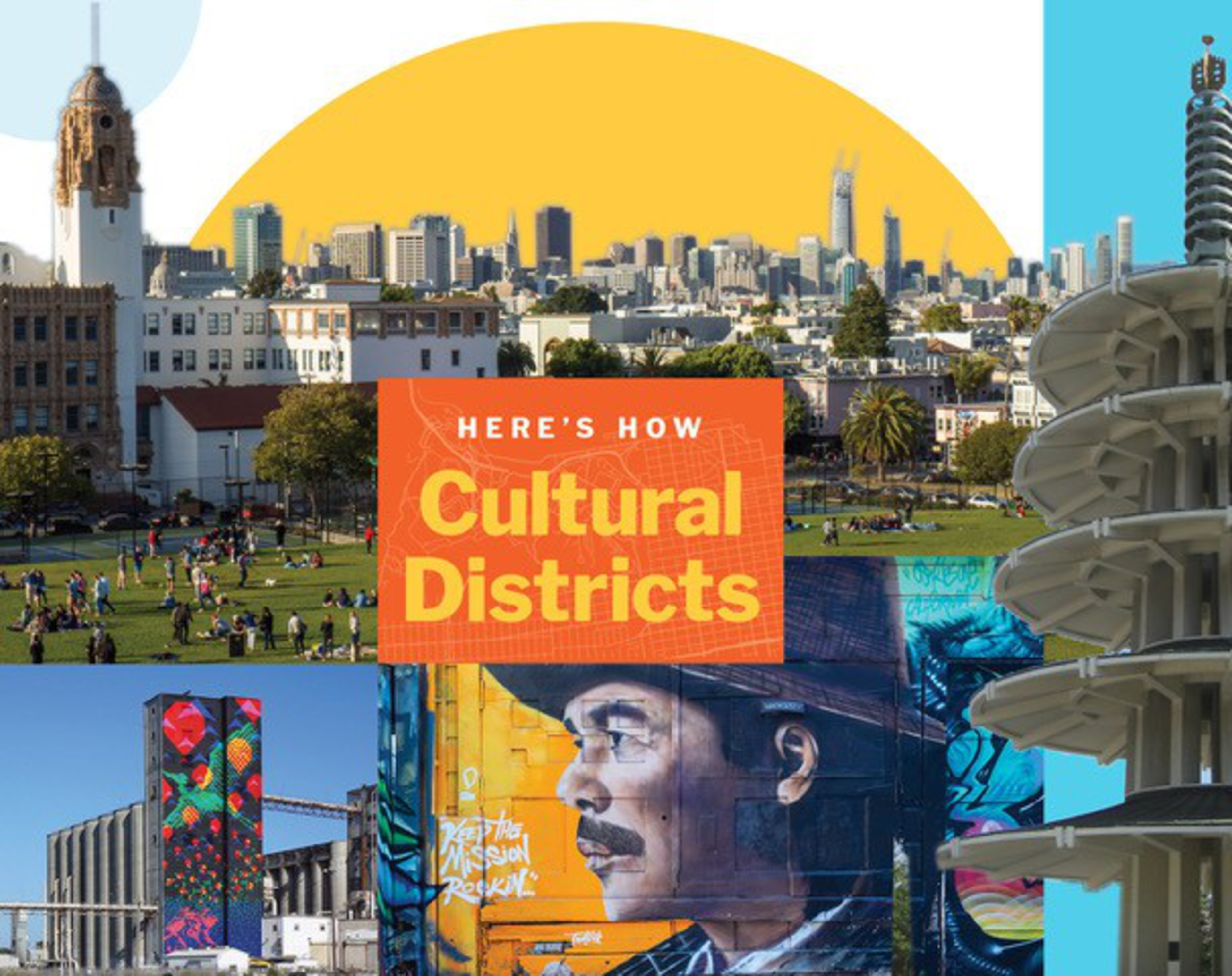In “Here’s How,” we’re breaking down how the city works, piece by piece. Up first: San Francisco’s 10 designated cultural districts.
San Francisco is a world-class city known for its patchwork of ethnically and culturally distinct neighborhoods. They’re also the backbone of the city’s economy. According to SF Travel (opens in new tab), in 2019, an estimated 26.2 million tourists traveled to San Francisco and spent approximately $10.29 billion on the city’s businesses and attractions.
While San Francisco’s tourism industry drastically declined (opens in new tab) due to the pandemic, there are residents working to make sure that the city’s neighborhood amenities are here to stay. They are well connected to city leadership and dedicated to ensuring that San Francisco’s economy makes a strong comeback. They have installed murals, financially supported parklets for businesses under the Shared Spaces (opens in new tab) program, and are focused on equity and cultural preservation. These residents are part of San Francisco’s cultural districts.
A cultural district is a geographic area (opens in new tab)within San Francisco that “embodies a unique heritage” and receives financial support from the city. Each district is defined by its residents’ cultural and historical contributions to the city, like locally-owned businesses, music venues, colorful murals and festivals.
How Are Cultural Districts Created?
Cultural districts are created and legislated by a District Supervisor who represents that area. The District Supervisor appoints a steering committee consisting of business owners, community leaders and property owners to establish the cultural district’s geographic boundary.
After a series of meetings, the steering committee meets with its District Supervisor to seek approval for the district’s geographic boundary. Once the Supervisor approves the boundary, they draft legislation and present it before the full Board of Supervisors (opens in new tab). When the full board approves the legislation, a cultural district is born. This process takes about six months to a year.
Why Does The City Need Cultural Districts?
Cultural districts exist to correct the city’s history of inequitable practices (opens in new tab) that led to gentrification (opens in new tab). The districts’ steering committees work directly with the Board of Supervisors and the Mayor’s Office of Housing and Community Development (opens in new tab) (MOHCD) on neighborhood-specific policies that benefit each district’s residents.
“The cultural districts program is an opportunity to use public policy as a tool to amplify healing,” said Julia Sabory, who manages the program for MOHCD. “This work is done by addressing historical and present-day trauma, while also building for a better day for our children and our children’s children. We all deserve a space to feel safe, a place to feel welcome and a place to call home.”
Part of that healing is acknowledging the history of the land on which the district was built. For example, in December of 2020, after meetings with the American Indian Cultural District (opens in new tab), Supervisor Hillary Ronen, as part of the Rules Committee, made a motion (opens in new tab)to include Dolores Park as part of that district’s boundaries.
The Rules Committee subsequently passed a motion (opens in new tab) to include a statement acknowledging the Native heritage of San Francisco as a standard procedure at the start of all Board of Supervisors meetings.
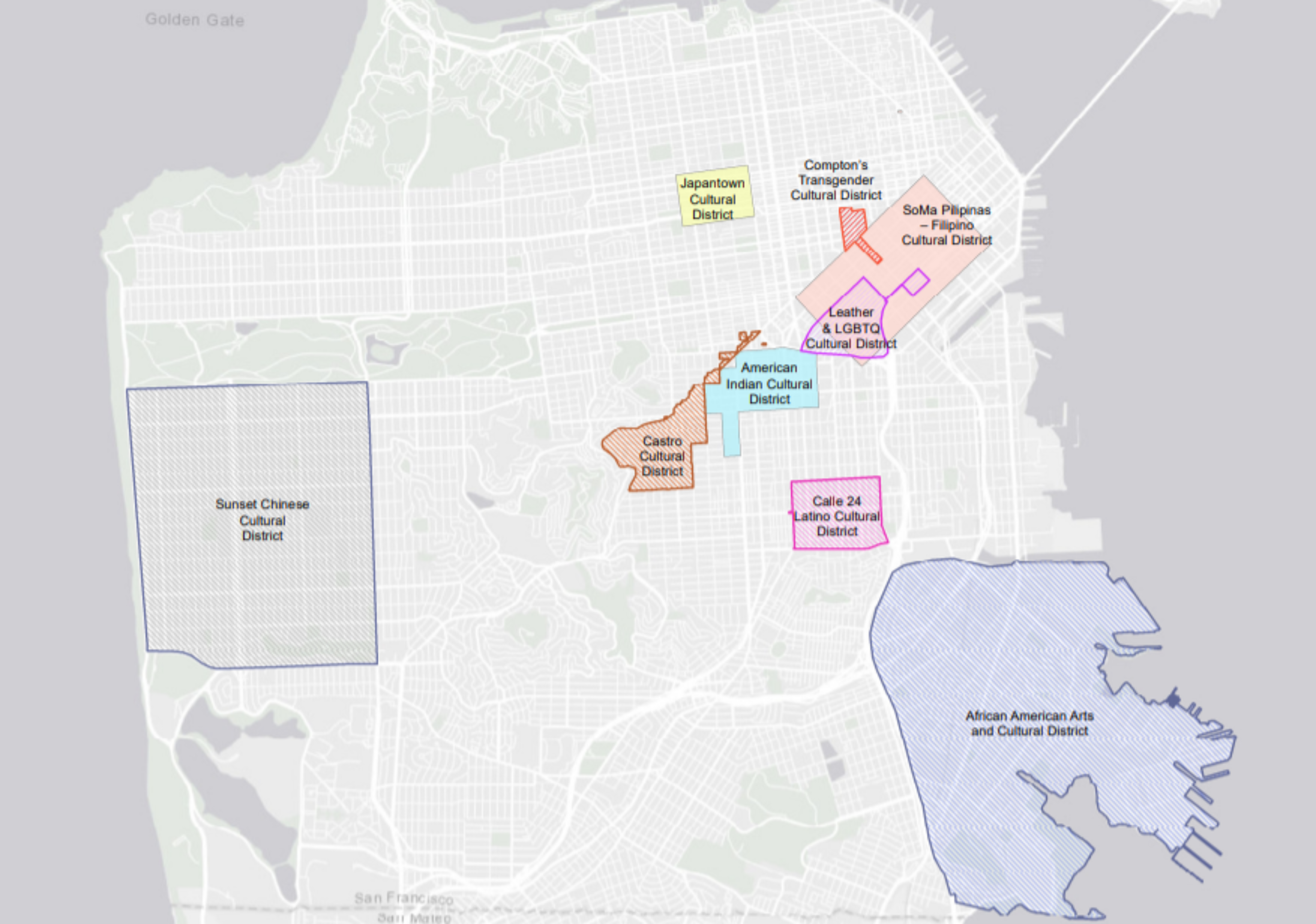
What Do They Accomplish?
Each cultural district’s steering committee is responsible for championing community-strengthening policies. The committees advocate for small businesses, resist development of chain businesses, prioritize affordable housing and make sure workers are paid living wages. This work is done to ensure that cultural districts will benefit when San Francisco experiences the next surge of economic growth without neighborhood businesses or local residents being priced out of the city.
How Are They Funded?
MOHCD manages the seed funding for cultural districts, but the actual funds come from Prop E (opens in new tab), a ballot measure that shifted a portion of hotel tax revenue to arts and cultural services. The legislation’s baseline funding for cultural districts is $3 million. While the percentage of financing for each cultural district will likely fluctuate (opens in new tab) yearly, the program funding from Prop E is capped at 10% of hotel tax revenue, which guarantees a minimum amount for the program. “The legislation was smartly written,” added Sabory. “Although COVID has almost nearly wiped out tourism and hotel usage in 2020, it has saved the cultural district program, and this percentage cap will ensure that they are always funded.”
SF’s Cultural Districts
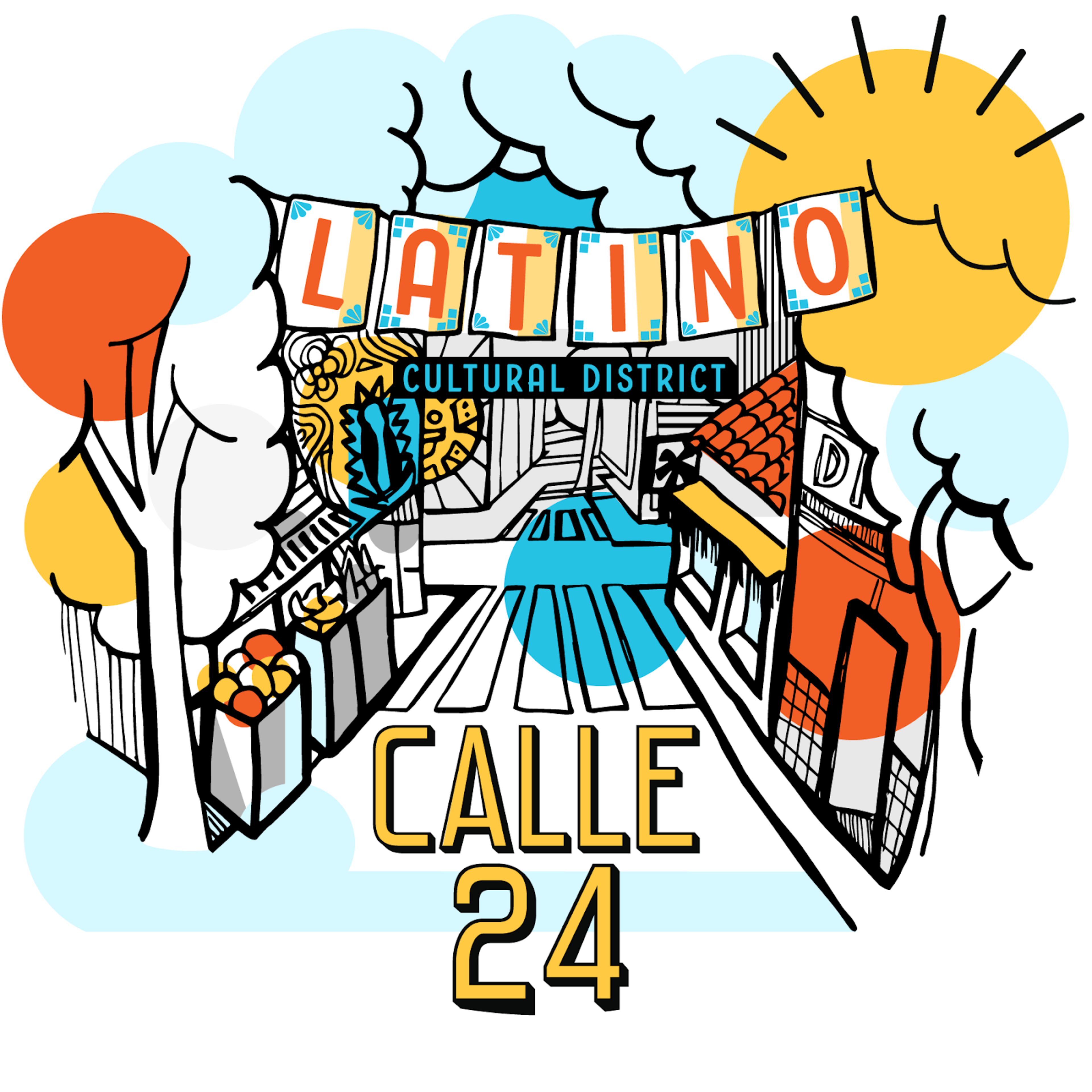
Calle 24 Latino Cultural District (opens in new tab) – Est. 2014
In 2014, Supervisor David Campos (formerly District 9) introduced a resolution (opens in new tab) to designate a portion of San Francisco’s Mission District as the “Calle 24 Latino Cultural District” to recognize the impact of the city’s Latino community. This cultural district, which spans 24th Street from Mission to Potrero Avenue, commemorates historical moments like the establishment of Galería De La Raza (opens in new tab) and the Central American Solidarity (opens in new tab) movement, which took place in the ’70s and ’80s. In the late ’90s (opens in new tab), Latino business owners, artists and community-based organizations continued to build on that momentum by advocating for anti-displacement.
Currently, Calle 24 is continuing efforts (opens in new tab) to maintain the Latino community’s presence in San Francisco. They are also helping to lead the Latino task force in the battle against COVID-19 with a pop-up testing site in the district.

Japantown Cultural District (opens in new tab) – Est. 2014
San Francisco’s Japantown is the largest of the three remaining historic Japantowns in the United States. The neighborhood was originally established after the 1906 earthquake and fire that displaced many Japanese Americans from their homes in Chinatown. The Japanese community relocated to the city’s present-day Japantown in the Western Addition.
Today the neighborhood is home to numerous Japanese-themed attractions. For example, the iconic Peace Pagoda (opens in new tab), a five-tiered concrete stupa was a gift from San Francisco’s sister city Osaka, Japan. While Japantown’s businesses are in danger of permanent closure (opens in new tab) due to unsuccessful tenant negotiations with landlords, members of Japantown’s cultural district (opens in new tab) recently partnered with the Japantown Community Benefit District (opens in new tab)to launch a small business assistance center. The future center will provide business infrastructure support.

Compton’s Transgender Cultural District (opens in new tab) – Est. 2017
This cultural district has roots in a riot that happened in August 1966 at Compton’s Cafeteria (opens in new tab) on Taylor Street. The restaurant was known as a common stop for cops responding to late-night rowdy patrons. Among those patrons were transgender sex workers, drag queens, lesbians and gay men. At the time, tension between police and the LGBTQ community was high due to police brutality reports involving the LGBTQ community. One evening a trans woman, fed up with police harassment, threw a cup of coffee (opens in new tab) in an officer’s face, which sparked an uprising. This act of resistance cemented the legacy of the trans community in San Francisco and inspired the world’s first trans cultural district (opens in new tab) right in the city’s storied Tenderloin neighborhood. The district serves as a refuge for the trans community. Leaders of the community advocate against social and structural violence, marginalization, disenfranchisement and abject poverty.
The Transgender Cultural District recently finished a transgender entrepreneurship program and is rolling out a housing subsidy program that will soon be announced.

SOMA Pilipinas Cultural District (opens in new tab) (opens in new tab)– Est. 2016
The history of Filipino culture in San Francisco dates back to the 1920s when Filipino immigrants and merchant mariners, also known as the Gran Oriente Filipino Masonic fraternity (opens in new tab), pooled their money to buy SoMa’s Grand Oriente Filipino Hotel for $6,000. Fast forward to the 1960s, to attract tourists, San Francisco redeveloped SoMa, and eventually built Yerba Buena Center and The Moscone Center, which displaced 4,000 elders, retirees, Filipinos and other working-class people. SOMA Pilipinas, which spans (opens in new tab) Market and Brannan Streets from 2nd to 11th Streets and serves as the city’s Filipino cultural district, ensures that future tourism initiatives do not put them at risk for displacement.
Today, SOMA Pilipinas have reclaimed the tourism market by hosting popular events such as UNDISCOVRD (opens in new tab), a festival that highlights Filipino street food and art. Another major project in the works involves the activation of Kapwa gardens (opens in new tab), an outdoor space which SOMA Pilipinas plans to transform into a media, cultural arts and wellness venue.

African American Arts and Cultural District (opens in new tab) – Est. 2018
Historically, Bayview has been the center of Black culture (opens in new tab) in SF. After World War II brought an influx of Black migrants from the South, the Bayview was one of a few neighborhoods where African Americans could settle down due to redlining (opens in new tab). With the current population of Black San Franciscans hovering around 5% (opens in new tab), down from 13.4% in 1970, the cultural district is working to preserve and highlight black culture in San Francisco.
Today, the African American Arts and Cultural District focuses on financial literacy outreach to increase Black homeownership and grant programs to support neighborhood beautification initiatives like murals (opens in new tab) and business facade improvements.

Leather & LGBTQ Cultural District (opens in new tab) – Est. 2018
This SoMA district is also the hub (opens in new tab) of the gay leather scene (opens in new tab) and home to the annual Folsom Street Fair (opens in new tab), the world’s largest leather and fetish meetup. According to the District’s President, Bob Goldfarb, in the summer of 1980, there were “55 leather and LGBTQ businesses in the SoMa, and today there are only 14.” The Leather cultural district aims to rebuild that community by advocating for more business in the area and securing funding for more events to keep the neighborhood kinky and vibrant.
Currently, the Leather & LGBTQ Cultural District is working on branding itself with placemaking signage. Soon, the neighborhood will have public plaques commemorating historic locations. The steering committee also plans to develop a process (opens in new tab) for local artists to participate in district beautification.

Castro LGBTQ Cultural District (opens in new tab) (opens in new tab)– Est. 2019
This Castro cultural district was created to commemorate the gay liberation (opens in new tab) movement, the Summer of Love (opens in new tab) and the legacy of Harvey Milk (opens in new tab), who was the first openly gay District Supervisor in San Francisco. These movements, which took place in the ’60s and ’70s, contributed to San Francisco becoming known as a “gay Mecca (opens in new tab)” and bastion for self-expression. From the vintage trolleys to rainbow-striped flags and sidewalks, the Castro is not only the heart of the LGBTQ community but a central gateway to several San Francisco neighborhoods. Landmarks within the Castro LGBTQ Cultural District’s boundaries (opens in new tab)include the San Francisco LGBT Center (opens in new tab)and the Pink Triangle (opens in new tab).
The Castro LGBTQ Cultural District is in the process of developing a COVID-19 task force to identify needs, gaps and strategies for recovery. The district will be holding its inaugural town hall (opens in new tab) meeting on Saturday, March 20, from 2 p.m. to 4 p.m. to introduce its district director, advisory board members and discuss programming plans.

American Indian Cultural District (opens in new tab) – Est. 2020
The American Indian Cultural District (AICD) is San Francisco’s newest cultural district and the first of its size in the United States. It’s dedicated to recognizing, honoring and celebrating the legacies and contributions of American Indian people and cultures. The AICD is located primarily in San Francisco’s Mission neighborhood and straddles supervisorial districts 8 and 9.
The AICD is currently working on the “Indigenize Project (opens in new tab),” which is a cultural art and awareness project that will include a mural, banners and signage within the district and a QR code project that will highlight culturally significant sites.
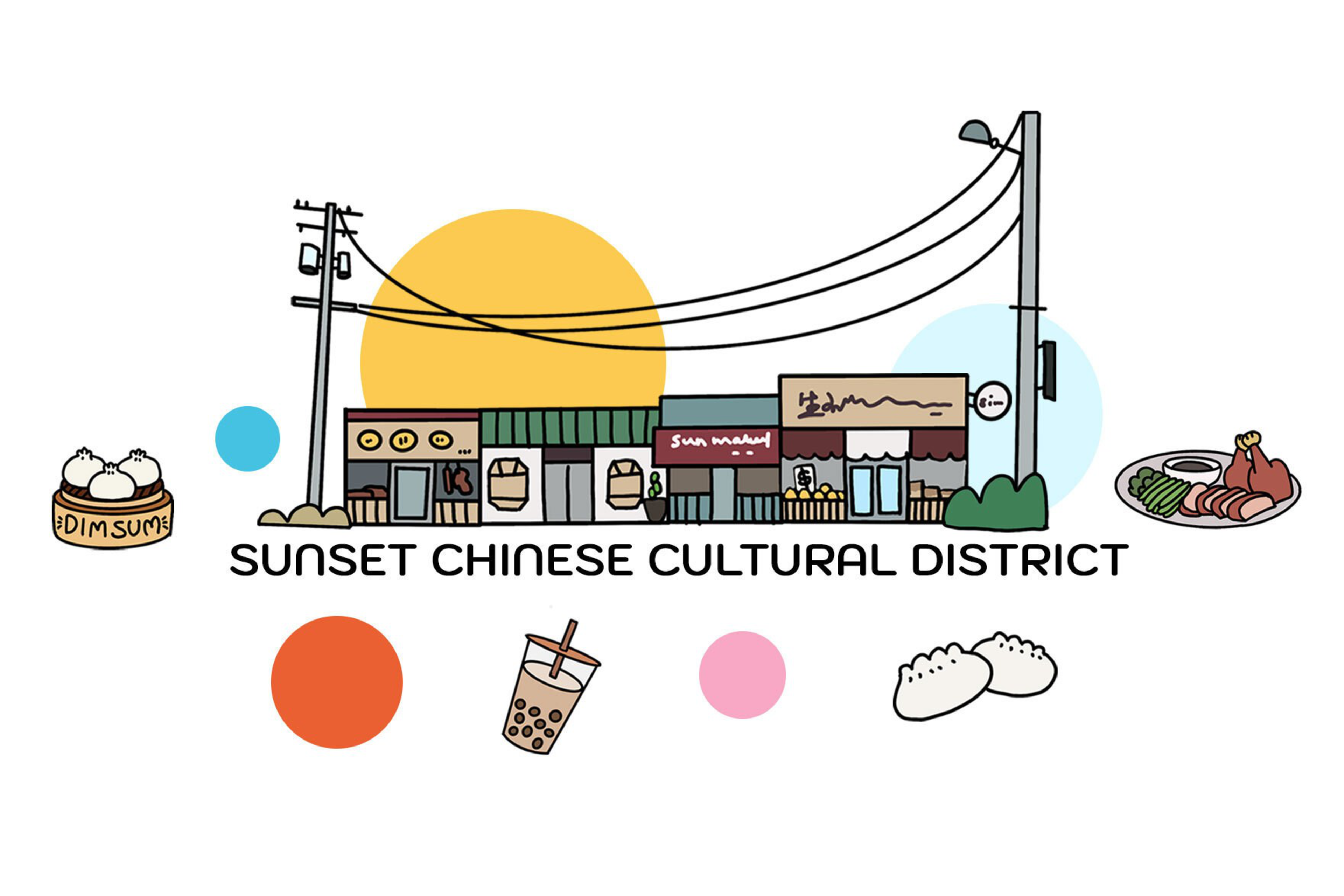
Sunset Chinese Cultural District (opens in new tab) – Est. 2021
The Sunset Chinese Cultural District—the ninth official cultural district in San Francisco and the first on the city’s west side (opens in new tab)—was established in 2021 by Supervisor Gordon Mar (opens in new tab) in response to the rising movement against anti-Asian hate.
Starting from the 1950s (opens in new tab), waves of Chinese American families moved to the Sunset District, leading to the flourishing of Chinese American businesses and the formation of cultural identity. Now, more than half of the Sunset’s residents are Asian Americans, and many of them are Chinese.
San Francisco has a long history of Chinese immigration and boasts the nation’s oldest Chinatown. The Richmond District is also called “New Chinatown” because of its large Chinese American population. Mar said in 2021 that the Sunset was ready (opens in new tab) to become the cultural district, and will work with other Chinese American communities in the city to preserve Chinese American history and traditional culture.
The main cultural and celebration events include Lunar New Year, Lantern Festival, AAPI Heritage Month(in May), and Moon Festival.
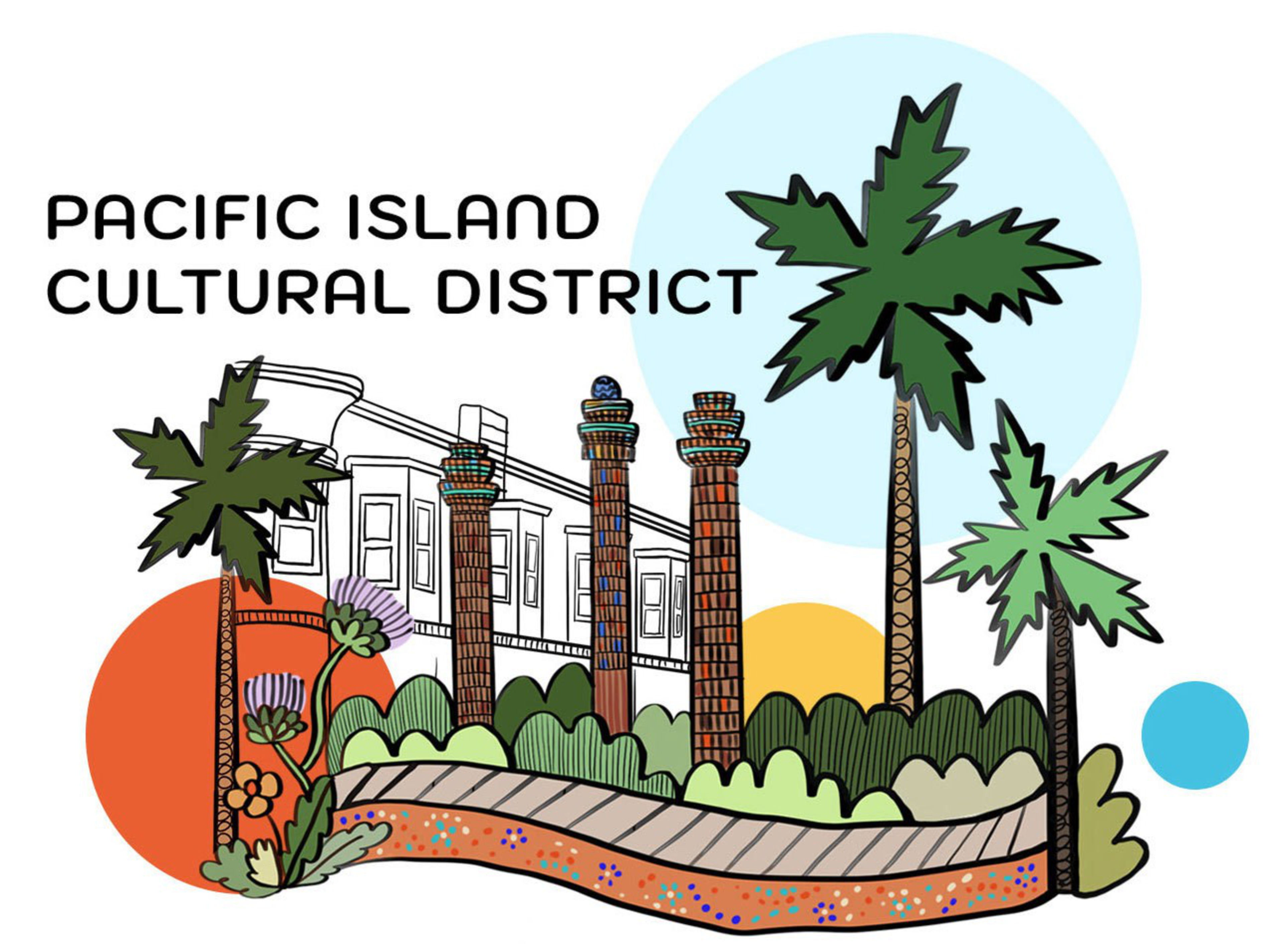
Pacific Islander Cultural District – Est 2022
On Sept. 27, District 10’s Sunnydale and Visitacion Valley communities were designated as the first Pacific Island Cultural District in the country by San Francisco Board of Supervisors President Shamann Walton. This is the 10th cultural district in San Francisco.
Many factors contributed to the Pacific Islander community’s early and later migrations to San Francisco—which spanned from the end of World War II through the 1980s. Pacific Islander families from American Samoa flocked to San Francisco for education and job possibilities. Some joined the military and worked at the Hunters Point Naval Shipyard, which is now deactivated. From 1951 until 1980, the Mormon Church encouraged and supported the migration of Pacific Islander communities from Tonga and Samoa to San Francisco for missionary work, while others were brought for agricultural labor.
The boundaries of the Pacific Islander Cultural District are primarily in Visitacion Valley, along Bayshore Boulevard, and parts of Geneva Avenue, McLaren Park, and Sunnydale. This specific area in San Francisco has been home to the majority of the city’s Pacific Islander population for more than a century.
Currently, the Pacific Island Cultural District is working on ways to tackle some of the inequities faced within their community, such as poverty, gun violence and chronic truancy. They also are looking at ways to revive their cultural food hub that was once prominent along Geneva Avenue. After it is approved by the full Board of Supervisors, the Cultural District will be recognized as the tenth Cultural District in San Francisco and have access to all the resources provided by MOHCD.
What’s Next For San Francisco’s Cultural Districts?
As San Francisco works toward fully reopening its economy, all of these cultural districts are hosting regular meetings alongside MOHCD to strategize how they will fit into the city’s “new normal,” uplift residents’ voices and remedy past wrongs.
“We’re not just working with a majority of people who have systemic power in government or policy,” Sabory noted. “We’re talking about working with people who’ve been marginalized and oppressed by historical racist policies. So this is a legislated policy to amend those wrongdoings.”
While today’s San Francisco looks different from its past and faces challenges to recoup lost tourism dollars, Sabory has faith that the city’s landscape will improve based on the momentum driving cultural districts.
“I think it’s very powerful that we’re investing in community leadership for self-sustainability and self-empowerment,” said Sabory. “A cultural district is not creating anything new. We are bringing light to the beauty of these communities that’s already there. My hope is that people feel stronger now that their history, languages and faces are being amplified.”
To keep up with the latest efforts of San Francisco’s cultural districts, visit SF Planning’s website (opens in new tab) or take some time to visit one for yourself.
Artwork by Meli Grosa (opens in new tab) and Lu Chen.
